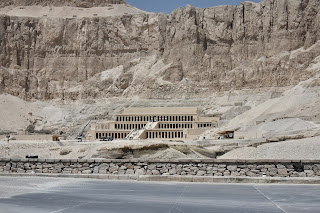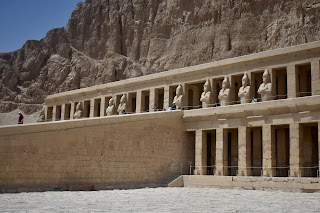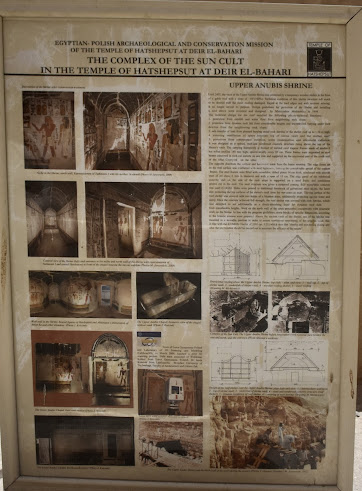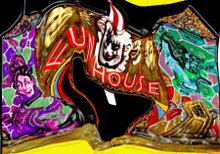Day 6 September 2 Part 4: Hatshepsut's Temple Valley of the Queens
So after such a dazzling tomb we were off to see something completely different. We loaded into the bus and drove through the Valley of the Queens. We saw the typical desert landscape resplendent with archaeological possibilities
There were definitely ancient things to explore everywhere in Deir al Bahari, the necropolis of ancient Thebes.
But we were headed for the famous Temple of Hatshepsut, (Djeser Djeseru)
a magnificent terraced structure built in the 18th Dynasty.
Above it looms the mountain El Qurn, whose pyramid shape may be the reason that this site was chosen for the necropolis.
Necropoleis were situated on the West Bank of the Nile (where the sun set and went into the underworld.) Temples for the living were on the East bank where the sun rose, symbolizing life's beginning. Hatshepsut's mortuary temple faces Karnak which is on the other side of the Nile and is aligned perfectly with the 8th pylon, a monument that Hatshepsut also caused to be built. It is theorized, that the barque of Amun-Re, the sun god, would be launched for the Beautiful Festival of the Nile, and would sail in perfect East/West alignment to arrive directly at the Mortuary Temple.
It seemed to me like the temple dogs were increasingly well fed as we continued on our trip. I had started packing little bits of breakfast to feed the temple animals and wondered if other tourists were doing the same, or perhaps the people in the south were away from the frantic life of Cairo and had more time and sympathy for the animals.
One of the first things pointed out to us by our guide was the remains of a myrrh tree brought back to Hatshepsut from her famous expedition to Punt (most likely located in modern day Somalia). Primary murals of the temple depict this expedition which reputedly brought back great riches.
Hatshepsut (1507-1458 BCE) was probably the second woman to serve as King in Egypt (after Sobekneferu/Nefrusobek of the Twelfth Dynasty). She was the daughter of Thutmose I and his sister Ahmose. Married to her half brother, Thutmose II, when he died she served as regent for her two year old nephew/stepson Thutmose III. Eventually she decided not to turn the throne over to Thutmose III and extended her rule from about 1479 - 1458 BCE ruling as the fifth Pharaoh or King of the 18th Dynasty.
Hatshepsut had one of the most peaceful and prosperous reigns in ancient Egyptian history. She was the most prolific builder up to that time constructing not only large parts of the Temple at Karnak, but the Mortuary Temple at Deir al-Bahari seen above.
As a woman, Hatshepsut had to wage a massive media campaign to convince her people that she was as worthy as the male leaders to reign as King of Egypt. This statue in the Metropolitan Museum in New York shows what I think she most looked like.
The large head we saw in the Egyptian Museum bears the mark of her media campaign in which her features are masculinized and she wears the false beard of the pharaohs to show she has the strength and wisdom to rule.

It is the same face basically, but it has been masculinized. This was also done with the statues of her at Djeser Djeseru.

You can see that many of the statue figures are missing or damaged. Thutmose III many years after he finally did come to the throne mounted a major campaign to remove Hatshepsut's presence from the temple and history in general. The temple also suffered from earthquakes and later desires to efface the ancient gods.
Imagine the structure with a statue of Hatshepsut along every pillar!
Inside the porticos are images which speak of the divine birth of Hatshepsut (thus emphasizing her right to be King) and of expeditions (seen below) she sent to the legendary land of Punt.
These images are found on the left hand side of the ramp to the third level.
On the right hand side are images showing the divine birth of Hatshepsut.
In general the images are not in terribly good condition (at least in comparison to what we had just seen in Nefertari's tomb.)
On the sides of the main structure are smaller temples dedicated to Hathor and Anubis.
Above nemset jars are offered to the god Horus. I wonder if that isn't Thutmose III (who supposedly replaced some images of Hatshepsut with his own in his attempts to erase her from the temple.) It might also be Thutmose I (Hatshepsut's father) who also makes appearances along with Hatshepsut in the temple reliefs.
I couldn't resist taking a few romanticized photos of ruins!
The Hathor temple has a colonnade of columns bearing her likeness.
Who is that guy in my picture!? ;-) It's one of our colleagues on the trip!
This is an entry gate in the Hathor temple.
Here you see an effaced image (probably of Hatshepsut?) before Hathor in her cow guise.
There is something quite attractive about this relief of Hathor
The temple of Anubis lies on the righthand side of the temple.
The sign gives some information about a joint Egyptian/Polish undertaking to conserve the Anubis temple.
Below you see a familiar scene of a king with a pile of offerings (Thutmose I or III?)
It is too bad that the reliefs are so hard to see now.
Unfortunately it is also quite dark and the images are badly damaged,
but that does not detract from the magnificence of the building itself and its design.
It had been a very long and impressive day, but we were really quite tired by now and as pleasant as it had been, we were ready to go home and have some lunch.
Goodbye to the protective sphinx outside of Djeser Djeseru.
back on the bus we passed all kinds of interesting things of course.
Remember these guys? We didn't stop at them on the way in, but on the way back we stopped for our mandatory shots of the so-called Colossi of Mnemnon.
We hadn't stopped at them on the way in, so it was mandatory to stop now. If you remember your Iliad, Mnemnon was an Ethiopian King who came to the aid of Troy and ended up killing Antilochus. (Wikipedia Image from Museés Royaux d’Art et d’Histoire, Brussels.)
So, why did anyone think these were statues of Mnemnon?
The Colossi were wrongly thought to be of Greek King Mnemnon, because of the graffiti found on the northernmost statue.
Egyptologists believe that these are actually representations of Amenhotep III and they stand guard (sadly ineffectively) in front of what once was the largest Temple in the Theban Necropolis.
The temple seems to have met its end through mostly natural causes: floods and earthquakes, but in its glory days, the temple complex stretched over 86 acres and dwarfed Karnak and all other temples of the time.
We were exhausted and very happy to get back in the bus and just watch whatever passed our way.
We were hungry, so the fruit looked really enticing. It was so hard to believe that we had seen so much already today and we hadn't even had lunch yet!
Below you can see one of the strategies used by people in this part of the world. People like to add floors to their homes for new generations, so they often leave the top floor ready for another level. It has the added benefit of making the home "unfinished" and thus excluded from taxes.
Before we knew it we were back at the Avenue of the Sphinxes ...
...and passing by the Luxor Heritage Center and Library again.
When we got back to the ship we finally got to have lunch. Here we dined with new friends.
Thank goodness we had a bit of a break in the afternoon. Viking had arranged for us to have backgammon lessons or to learn some Arabic and best of all, to rest a little in preparation for one last excursion of the day.
That evening we were entertained with Egyptian music and dance.

























































No comments:
Post a Comment